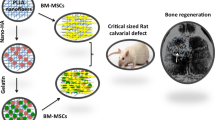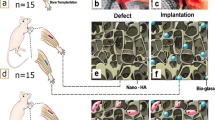Abstract
Bone self-healing is limited and requires additional or external intervention to promote and accelerate bone regeneration. Therefore, the aim of this study was to investigate the potential capacity of hydrogel collagen (Co) nanocomposite alone, and in combination with 2% strontium (Co/BGSr2%) in presence of mesenchymal stem cells (MSCs) in full-thickness bone defect regeneration in the rabbit animal model. A total of 72 New Zealand white rabbits were randomly divided in 6 groups of 12 rabbits with full-thickness bone defect. In five groups, the bone defect was treated with MSC, Co, Co/BGSr2%, Co + MSCs, and Co/BGSr2% + MSCs. No treatment was done in the control group. The treatments were assessed radiographically, histopathologically, and immunohistochemically on days 14, 28, 42, and 56 post-treatment. The highest radiographical and histological scores were belonged to the Co/BGSr2% + MSC followed by Co + MSCs, Co/BGSr2%, Co, MSC, and the control groups. The highest and lowest mean expression level of osteocalcin was detected in the Co/BGSr2% + MSC and control groups by 28th dayof post-implantation, respectively. In contrast, the highest and lowest mean expression level of osteocalcin on day 56 post-implantation was belonged to the control and Co/BGSr2% + MSC, respectively. The Co/BGSr2% nanocomposite scaffold seeded with MSC can accelerate bone regeneration resulted from osteoblastic production of osteocalcin protein. Therefore, collagen hydrogel combined with 2% strontium in nanocomposite form is a suitable candidate scaffold for bone tissue engineering.








Similar content being viewed by others
Data Availability
All data are available based on request via contacting with corresponding authors by email.
Code Availability
Not applicable
Abbreviations
- Co/BGSr: :
-
Collagen/bioglass/strontium
- PT: :
-
Post-treatment
- Co: :
-
Collagen
- MSCs: :
-
Mesenchymal stem cells
- IHC: :
-
Immunohistochemistry
References
Wang J, Liu S, Shi J, Liu H, Li J, Zhao S, Yi Z (2020) The Role of lncRNAs in osteogenic differentiation of bone marrow mesenchymal stem cells. Curr Stem Cell Res Ther 15:243–249
Bayat H, Shahabinejad H, Bayat M, Shirian S, Mohamadnia A, Alijani M, Godarzi A, Shojaei P, Shojaei S, Shevidi A, Bahrami N (2019) Osteogenic differentiation of follicular stem cells on nano-Saghez scaffold containing BMP2. J Orthop Surg Res 14(1):442
Oryan A, Alidadi S, Moshiri A, Maffulli N (2014) Bone regenerative medicine: classic options, novel strategies, and future directions. J Orthop Surg Res 9(1):18
Udomluck N, Koh WG, Lim DJ, Park H (2019) Recent developments in nanofiber fabrication and modification for bone tissue engineering. Int J Mol Sci 21(1):99
Wang S, Liu L, Zhou X, Yang D, Shi Z, Hao Y (2019) Effect of strontium-containing on the properties of Mg-doped wollastonite bioceramic scaffolds. Biomed Eng Online 18(1):119
Rashtbar M, Hadjati J, Ai J, Jahanzad I, Azami M, Shirian S, Ebrahimi-Barough S, Sadroddiny E (2018) Characterization of decellularized ovine small intestine submucosal layer as extracellular matrix-based scaffold for tissue engineering. J Biomed Mater Res B Appl Biomater 106(3):933–944
Badylak SF (2007) The extracellular matrix as a biologic scaffold material. Biomaterials 28(25):3587–3593
Takallu S, Mirzaei E, Azadi A, Karimizade A, Tavakol S (2019) Plate-shape carbonated hydroxyapatite/collagen nanocomposite hydrogel via in situ mineralization of hydroxyapatite concurrent with gelation of collagen at pH = 7.4 and 37°C. J Biomed Mater Res B Appl Biomater 107(6):1920–1929
Dinarvand P, Seyedjafari E, Shafiee A, Babaei Jandaghi A, Doostmohammadi A, Fathi MH, Farhadian S, Soleimani M (2011) New approach to bone tissue engineering: simultaneous application of hydroxyapatite and bioactive glass coated on a poly (L-lactic acid)scaffold. ACS Appl Mater Interfaces 3(11):4518–4524
Leslie SK, Cohen DJ, Boyan BD, Schwartz Z (2020) Production of osteogenic and angiogenic factors by microencapsulated adipose stem cells varies with culture conditions. J Biomed Mater Res B Appl Biomater 108:1857–1867
Rajan N, Habermehl J, Cote MF, Doillon CJ, Mantovani D (2006) Preparation of ready-to-use, storable and reconstituted type I collagen from rat tail tendon for tissue engineering applications. Nat Protoc 1(6):2753–2758
Bakhtiarimoghadam B, Shirian S, Mirzaei E, Sharifi S, Karimi I, Gharati G, Takallu S, Nazari H (2021) Comparison capacity of collagen hydrogel, mix-powder and in situ hydroxyapatite/collagen hydrogel scaffolds with and without mesenchymal stem cells and platelet-rich plasma in regeneration of critical sized bone defect in a rabbit animal model. J Biomed Mater Res B Appl Biomater. https://doi.org/10.1002/jbm.b.34867
Lane JM, Sandhu HS (1987) Current approaches to experimental bone grafting. Orthop Clin North Am 18:213–225
Han Z, Bhavsar M, Leppik L, Oliveira KMC, Barker JH (2018) histological scoring method to assess bone healing in critical size bone defect models. Tissue Eng Part C 24:272–279
Soleimanpour H, Shirian S, Oryan A, Daneshbod K, Bagheri N, Daneshbod Y (2011) Cytologic, immunocytologic, histopathologic and immunohistologic diagnosis of the poorly differentiated sertoli-leydig cell tumor. Acta Cytol 55(4):382–386
Schindeler A, McDonald MM, Bokko P (2008) Little DG (2008) Bone remodeling during fracture repair: the cellular picture. Semin Cell Dev Biol 19(5):459–466
Wu S, Liu X, Yeung KWK, Liu C, Yang X (2014) Biomimetic porous scaffolds for bone tissue engineering. Mater Sci Eng R Rep 80:1–36
Wu G, Feng C, Quan J, Wang Z, Wei W, Zang S, Kang S, Hui G, Chen X, Wang O (2018) In situ controlled release of stromal cell-derived factor-1alpha and antimiR-138 for on-demand cranial bone regeneration. Carbohydr Polym 182:215–224
Sarker B, Hum J, Nazhat SN, Boccacci AR (2015) Combining collagen and bioactive glasses for bone tissue engineering: a review. Adv Healthc Mater 4:176–194
Silva R, Fabry B, Boccaccini AR (2014) Fibrous protein-based hydrogels for cell encapsulation. Biomaterials 35:6727–6738
Zhang S, Dong Y, Chen M et al (2020) Recent developments in strontium-based biocomposites for bone regeneration. J Artif Organs 23:191–202
Bai X, Gao M, Syed S, Zhuang J, Xu X, Zhang XQ (2018) Bioactive hydrogels for bone regeneration. Bioact Mater 3:401–417
Namini MS, Bayat N, Tajerian R, Ebrahimi-Barough S, Azami M, Irani S, Jangjoo S, Shirian S, Ai J (2018) A comparison study on the behavior of human endometrial stem cell-derived osteoblast cells on PLGA/HA nanocomposite scaffolds fabricated by electrospinning and freeze-drying methods. J Orthop Surg Res 13(1):63
Bigham-Sadegh A, Torkestani HS, Sharifi S, Shirian S (2020) Effects of concurrent use of royal jelly with hydroxyapatite on bone healing in rabbit model: radiological and histopathological evaluation. Heliyon 6(7):e04547
Yu T, Pan H, Hu Y, Tao H, Wang K, Zhang C (2017) Autologous platelet-rich plasma induces bone formation of tissue-engineered bone with bone marrow mesenchymal stem cells on beta-tricalcium phosphate ceramics. J Orthop Surg Res 12(1):178
Zoch ML, Clemens TL, Riddle RC (2016) new insights into the biology of osteocalcin. Bone 82:42–49
Su CY, Fang T, Fang HW (2017) Effects of electrostatic field on osteoblast cells for bone regeneration applications. Biomed Res Int 13:1–9
Acknowledgements
We would like to thank Tehran University of Medical Sciences.
Author information
Authors and Affiliations
Contributions
Sadegh Shirian designed the study. The surgery and radiographic image analysis was done by Siavash Sharifi. Geleviz Gharati and Behnam Bakhtiarimoghadam contributed to all step of the study including IHC, cell culture, radiography, and pathology. Esmail Mirzaee contributed to the scaffold characterization. Iraj Karimi and Sadegh Shirian interpreted the IHC and histopathology sections. Hassan Nazari contributed to cell culture. Sadegh Shirian wrote the manuscript.
Corresponding authors
Ethics declarations
Ethics Approval
This study was approved by Ethical Committee of Shahrekord University.
Consent to Participate
Not applicable
Consent for Publication
Not applicable
Conflict of Interest
The authors declare no competing interests.
Additional information
Publisher's Note
Springer Nature remains neutral with regard to jurisdictional claims in published maps and institutional affiliations.
Rights and permissions
About this article
Cite this article
Gharati, G., Shirian, S., Sharifi, S. et al. Comparison Capacity of Collagen Hydrogel and Collagen/Strontium Bioglass Nanocomposite Scaffolds With and Without mesenchymal Stem Cells in Regeneration of Critical Sized Bone Defect in a Rabbit Animal Model. Biol Trace Elem Res 200, 3176–3186 (2022). https://doi.org/10.1007/s12011-021-02909-6
Received:
Accepted:
Published:
Issue Date:
DOI: https://doi.org/10.1007/s12011-021-02909-6




